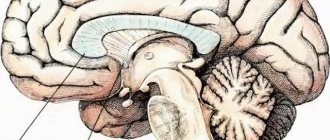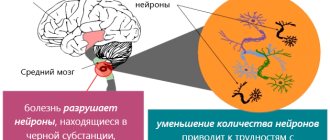Kinds
Before contacting a specialist for qualified help, it is important to determine the type of tingling (the medical definition is paresthesia). Thus, each type of illness speaks of various types of disorders in the body.
- The little finger of the right hand goes numb - the nerves are pinched and cervical osteochondrosis develops.
- Middle finger – damage to the cervical vertebrae of the collar zone occurs.
- Ring finger – if the finger is not pulled over the wedding ring, then muscle strain should be suspected.
- Numbness in the thumbs of the right and left hands - the cause may lie in a basic lack of vitamins, muscle strain or inflammation of the brachial nerve. But you should also be wary of more dangerous diagnoses, namely: pre-stroke condition, disturbances in the functioning of the nervous and cardiac systems.
- The index finger goes numb when the metabolic system does not work properly, or when the nervous system malfunctions due to stress and breakdowns.
- The little finger and ring fingers of the left hand – the functions of the cardiovascular system are impaired.
Reasons for numbness in fingers
- Carpal tunnel syndrome . In the early period, patients complain that all their fingers are numb in the morning, the feeling disappears by noon. Later, night discomfort is added, and over time, severe pain occurs. The brushes become weak and clumsy. A person has difficulty holding small objects. Without treatment, there is a high risk of irreversible damage to the median nerve.
- Polyarthritis (with rheumatoid arthritis, tuberculosis, psoriasis). The disease affects small joints. In addition to the fact that your fingers go numb during sleep, morning and night pain are also common. Stiffness, external swelling, and redness are evident.
- Osteochondrosis . When neurological structures are involved in the process, the spinal roots are inflamed, and the fingertips may go numb. The lesion can be unilateral or bilateral, and paresthesia often affects other parts of the upper limb.
- Metabolic pathologies . Diabetes mellitus, alcoholism, autoimmune diseases. The numbness is ascending, rising higher as the underlying disease progresses. Fingers go numb due to vascular spasm and severe circulatory problems. This is Raynaud's disease, atherosclerosis, scleroderma.
- Multiple hand injuries . Deformed bones and tissues cause trophic disorders, deterioration of blood flow and innervation.
- During pregnancy . In women, their fingers become numb and numb in their sleep position due to: weight gain;
- swelling;
- problems with hormonal levels;
- anemia;
- physical inactivity.
Causes
Paresthesia is not always associated with a painful condition of the body (neuralgia). Non-medical causes of numbness in the fingers include:
- general hypothermia of the body or upper extremities;
- consequence of hand injury;
- sleeping in an unnatural position;
- poisoning of the body with alcohol, drugs, chemicals;
- wearing tight-fitting jewelry (rings, bracelets);
- keeping your fingers in one position for a long time (knitting, typing on the keyboard).
REFERENCE! During pregnancy, a woman may experience numbness in her limbs due to the increased load on the body and hormonal changes.
If tingling is felt with constant frequency and is present in the same limb or finger, you should immediately contact a specialist for timely diagnosis and prescription of effective treatment.
Medical causes of the disease include:
- osteochondrosis;
- intervertebral hernia;
- tunnel syndrome;
- inflammatory processes in the joints;
- failure of the cardiovascular system;
- cerebral hemorrhage;
- brain activity disorders;
- improper blood circulation against the background of developing diabetes mellitus;
- thrombosis;
- disruption of the endocrine system;
- nail fungus;
- avitaminosis.
It should be borne in mind that the proper functioning of the body directly depends on the lifestyle that a person leads. Bad habits have a tremendous impact on the body's ability to function properly.
Diagnostics
The causes of numbness in the fingers must be identified for effective treatment. The location and severity of damage to nerve fibers is necessary. Doctors almost always order examination of the cervical spine and the elbow or wrist joint. Current diagnostic methods:
- ECG
- radiography
- MRI
- clinical tests
If there are complaints of loss of sensation in the thumb on the left limb, the doctor suspects pathology of the heart and blood vessels or osteochondrosis of the thoracic and/or cervical spine. Typical symptoms for such cases:
- the brush becomes weak
- muscle contractions become weaker
- your shoulder may hurt
- possible pain in the forearm (outer side)
If there are complaints of numbness of the thumb, atherosclerosis is suspected. With this pathology, the permeability of the blood vessel decreases, the vessels become less elastic, because a sufficient amount of blood and oxygen does not reach the hands. When she complains, numbness in the fingers of the right hand is suspected as one of the possible causes of cervical spondylosis; it does not occur in young people.
Complaints of numbness in the fingers of both hands indicate pernicious anemia. The cause of this pathology is a lack of B12 in the body. The cause may also be a tumor in the patient's brain. Complaints of symmetrical numbness in the fingers of both hands indicate polyneuropathy, which is often diagnosed in patients with diabetes.
Symptoms such as pale skin of the hands, pain in them, and numbness make it possible to suspect Raynaud's disease. The cause of this pathology can be prolonged cooling and multiple injuries.
Complaints of loss of sensitivity in the little and ring fingers of the right hand indicate damage to the cubital canal, which occurs when the ulnar nerve is compressed. Also, the brush becomes weaker. The following professions have an increased risk of this manifestation: engineer, musician, jeweler, seamstress, watchmaker, driver and others. Or it could be an injury, for example, received while playing sports.
Osteochondrosis is suspected in a patient if it is found that the cartilage has become less elastic, which has led to a pinched nerve. A person begins to experience pain in the chest – neck – shoulders area. Then my head hurts. The following manifestations are also typical:
- lethargy
- fatigue
- dizziness
- noise in ears
- mismatch of movement of different parts of the body
- blood pressure surges
- malfunctions of the vestibular apparatus
- "midges" before the eyes
Which doctor treats
For regularly recurring attacks of paresthesia, seeking professional medical help is a must. First of all, you need to make an appointment with a neurologist.
When choosing a clinic, you should take into account the presence of its own diagnostic facilities, the experience and qualifications of the working specialists (in particular, neurologists).
ATTENTION! The Kuntsevo Treatment and Rehabilitation Center has an extensive diagnostic base in all possible areas (MRI, ultrasound, electroneuromyography, etc.) to quickly and accurately determine a patient’s diagnosis.
Basic tests and procedures to make a correct diagnosis:
- blood and urine tests;
- blood sugar level analysis;
- Ultrasound, ECG of the heart muscle;
- MRI of the hand;
- Dopplerography of blood vessels, etc.
If necessary, additional studies will be ordered to more accurately diagnose the patient.
Depending on the nature of the origin of the symptom, based on the tests performed, the specialist will prescribe the most effective treatment in each specific case. The clinic employs the best neurologists, orthopedic traumatologists, rheumatologists, endocrinologists, cardiologists, chiropractors, rehabilitation specialists and other specialized specialists with many years of experience.
Numbness of the fingers is a sign that indicates neurological disorders in a person’s limbs.
IMPORTANT! A slight decrease in sensitivity can become a real problem after some time if timely treatment is not started by a qualified specialist.
Self-medication, as in all other cases, threatens not only to complicate the situation, but also to develop other neurological disorders. Therefore, make an appointment with an experienced neurologist at our center, who will conduct a full range of diagnostics, determine the causes of your condition and prescribe effective treatment.
Sign up
Treatment methods
Treatment for numbness in the fingers is carried out in several ways.
- Drug therapy. The doctor selects a course of effective, maximally safe medications, creams or ointments to relieve inflammation, relieve swelling and eliminate severe pain.
- Local treatment. In this case, therapeutic massage or manual therapy is used.
- Physiotherapy. Treatment is carried out with laser, magnet or ultrasound. As a result of this approach, blood circulation in the body is normalized and damaged tissues are regenerated.
- Exercise therapy and gymnastics. Relieves pain, restores normal sensitivity in the limbs, and alleviates the general condition.
IMPORTANT! The priority area of work of the CLRC is conservative therapy. The prescription of powerful, at the same time safe, pain-relieving drugs is combined with manual therapy, physical therapy, physiotherapy and massages. Only an integrated approach will help achieve the desired result quickly and for a long time.
Causes of numbness in fingertips
Possible causes of loss of sensation in the fingertips:
- osteochondrosis of the cervical vertebrae
- iron deficiency in blood plasma
- diabetes
- pancreatitis
- professional characteristics of work
- diseases associated with dysfunction of the endocrine glands
- joint diseases of various natures
- venous blood stagnation
- hypertension
- polyneuropathy
If you are not sure what exactly the disease caused the numbness, it would be a good idea to learn and do certain exercises. They will help restore blood flow to the extremities and, possibly, eliminate the causes of numbness in the fingers. You can perform the exercises sitting or standing.
Exercise 1. Raise your two arms up, shake them, then lower them. Repeat this 10 times.
Exercise 2. Sit or stand. Spread your arms to the side and extend them parallel to the floor. Rotate them first clockwise and then counterclockwise. Repeat 10-12 times.
Exercise 3. Sit or stand. Keep your hands parallel to the floor, gather the phalanges of your fingers into a fist. Rotate your wrist first clockwise and then counterclockwise. Repeat 10-12 times.
Exercise 4. Sit with a straight back on a chair. Rotate your head: first in one direction, then in the other, then from top to bottom and back. Avoid jerking, smoothness is important here. Repetitions: about 10 times.
Exercise 5 . Place your hands in front of your chest so that the palm of your right hand touches the palm of your left limb, and rub one hand against the other.
Exercise 6 . Maintain the starting position similar to exercise 5. But only the pads of your fingers should touch. Massage, press them on each other. Then massage your fingers and palm with the other with one hand, then change hands.
If the numbness in your fingers does not go away at one time, then repeat all these exercises after a few hours.
Rehabilitation and lifestyle restoration
Rehabilitation programs at the CLRC are developed in different directions in order to select the most effective one in each individual case.
- Physiotherapy.
- Manual therapy.
- Reflexology.
- Physiotherapy.
- Massage.
- HILT therapy.
- Shock wave therapy (SWT).
- Electrotherapy (SMT therapy).
- Electrophoresis with Karipazim.
- Dry traction of the spine.
- Laser therapy.
- Rehabilitation after endoprosthetics.
Lifestyle with paresthesia
To eliminate the possibility of a return of symptoms of paresthesia, it is necessary to adhere to the basic rules of maintaining a healthy lifestyle.
- Do not drink alcohol, nicotine, or drugs.
- Eat well. Eliminate food waste from your diet (sugar, white flour, preservatives, etc.)
- Meals should be fractional. Avoid overeating.
- Periodically monitor blood glucose levels and measure blood pressure.
- Exercise regularly.
- Maintain a daily routine.
- Sleep at least 8 hours a day.








